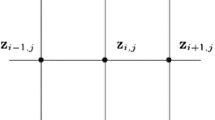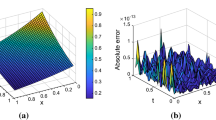Abstract
This paper solves the advection–diffusion equation by treating both advection and diffusion residuals in a separate (non-unified) manner. An alternative residual distribution (RD) method combined with the Galerkin method is proposed to solve the advection–diffusion problem. This Flux-Difference RD method maintains a compact-stencil and the whole process of solving advection–diffusion does not require additional equations to be solved. A general mathematical analysis reveals that the new RD method is linearity preserving on arbitrary grids for the steady-state advection–diffusion equation. The numerical results show that the flux difference RD method preserves second-order accuracy on various unstructured grids including highly randomized anisotropic grids on both the linear and nonlinear scalar advection–diffusion cases.























Similar content being viewed by others
References
Abgrall, R.: Toward the ultimate conservative scheme: following the quest. J. Comput. Phys. 167(2), 277–315 (2001)
Abgrall, R., Roe, P.: High-order fluctuation schemes on triangular meshes. J. Sci. Comput. 19(1), 3–36 (2003)
Abgrall, R., Santis, D.D., Ricchiuto, M.: High-order preserving residual distribution schemes for advection–diffusion scalar problems on arbitrary grids. SIAM J. Sci. Comput. 36(3), A955–A983 (2014)
Brenner, S., Scott, L.: The Mathematical Theory of Finite Element Methods, Text in Applied Mathematics, vol. 15. Springer, Berlin (1994)
Deconinck, H., Ricchiuto, M., Sermeus, K.: Introduction to residual distribution schemes and comparison with stabilized finite elements. Technical report, von Karman Institutefor Fluid Dynamics (2003)
Deconinck, H., Roe, P.L., Struijs, R.: A multidimensional generalization of Roe’s flux difference splitter for the Euler equations. Comput. Fluids 22(2), 215–222 (1993)
Deconinck, H., Struijs, R., Bourgeois, G., Roe, P.: Compact Advection Schemes on Unstructured Meshes. VKI Lecture Series: Computational Fluid Dynamics, vol. 24, von Karman Institute for Fluid Dynamics, Belgium (1993)
Ismail, F., Chang, W.S., Chizari, H.: On flux-difference residual distribution methods. Bull. Malays. Math. Sci. Soc. (2017). https://doi.org/10.1007/s40840-017-0559-8
Ismail, F., Chizari, H.: Developments of entropy-stable residual distribution methods for conservation laws I: scalar problems. J. Comput. Phys. 330, 1093–1115 (2017)
Masatsuka, K.: I Do Like CFD, book, vol. 1, lulu.com, USA (2009)
Mazaheri, A., Nishikawa, H.: Improved second-order hyperbolic residual-distribution scheme and its extension to third-order on arbitrary triangular grids. J. Comput. Phys. 300(1), 455–491 (2015)
Nishikawa, H.: A first-order system approach for diffusion equation. I: second-order residual-distribution schemes. J. Comput. Phys. 227(1), 315–352 (2007)
Nishikawa, H.: A first-order system approach for diffusion equation. II: unification of advection-diffusion. J. Comput. Phys. 229(11), 3989–4016 (2010)
Nishikawa, H., Roe, P.: On high-order fluctuation-splitting schemes for Navier–Stokes equations. In: 3rd ICCFD Conference, Toronto (2004)
Nishikawa, H., Roe, P.: High-order fluctuation-splitting schemes for advection–diffusion equations. In: 4th ICCFD Conference, Ghent (2006)
Ricchiuto, M., Villedieu, N., Abgrall, R., Deconinck, H.: On uniformly high-order accurate residual distribution schemes for advection–diffusion. J. Comput. Appl. Math. 215(2), 547–556 (2008)
Roe, P.: Characteristic-based schemes for the Euler equations. Ann. Rev. Fluid Mech. 19, 337–365 (1986)
Rubino, D.: Residual distribution schemes for advection and advection–diffusion problems on quadrilateral and hybrid meshes. Ph.D. thesis, Politecnico Di Bari (2006)
Struijs, R., Deconinck, H., Roe, P.: Fluctuating Splitting Schemes for the 2D Euler Equations. VKI Lecture Series: Computational Fluid Dynamics, vol. 22, von Karman Institute for Fluid Dynamics, Belgium (1991)
Villedieul, N.: High order discretisation by residual distribution schemes. Ph.D. thesis, Universit Libre De Bruxelles (2009)
van der Weide, E.: Compressible flow simulation on unstructured grids using multidimensional upwind schemes. Ph.D. thesis, Delft University of Technology (1998)
Acknowledgements
We would like to thank Malaysian Ministry of Higher Education under the Fundamental Research Grant (No. 203/PAERO/6071316). In addition, we would like to thank Professor Rémi Abgrall for his feedback on the paper as well providing the proof of LP of the new Flux-Difference approach in the “Appendix”.
Author information
Authors and Affiliations
Consortia
Corresponding author
Appendix by Rémi Abgrall
Institut für Mathematik Universität Zürich, Zurich, Switzerland. E-mail: remi.abgrall@math.uzh.ch
Appendix by Rémi Abgrall
The problem is defined in \({\varOmega }\subset \mathbb {R}^2\). The case \(\mathbb {R}^3\) could be done the same by replacing the 1/2 factor to 1/3. The boundary conditions could also be dealt similarly.
The residual is
where \(\varphi _i\) is the basis function, \(\mathbf {n}_i=\int _T\nabla \varphi _i \;d \mathbf {x}\). The as in [12,4], consider a test function v and its interpolant \(v^h=\sum \limits _iv_i\varphi _i\). The scheme is
where
Then we multiply by \(v_i\), sum over all degrees of freedom and get:
Similarly, if \(u^h\) is the piecewise linear interpolant of the exact solution, we can define the truncation error as,
Now we also know that the exact solution \(u^{ex}\) satisfies
So taking the difference, the truncation error is,
Then, clearly if v is sufficiently regular, \(\mathbf {f}^\star _T( u^{ex,h})-\mathbf {f}( u^{ex})=O(h^2)\) (at least for the choices of the paper), and \(\nabla \big ( u^{ex,h}- u^{ex}\big )=O(h)\). This indicates that
The second inequality shows it is O(h) but using the Aubin–Nitsche approach [4], we have that
and using Poincaré inequality (possible since v has a compact support), we get that \(||v||_{L^2}\le C ||\nabla v||_2\) for some \(C>0\) that only depends on \({\varOmega }\). Collecting the two together, we see that the viscous term
behaves like \(O(h^2)\) in reality.
So in generality the scheme has a truncation error \(O(h^2)\) provided that
This is also true under the assumptions of the paper since on each element,
and then,
where \(v_T\) is the value at one arbitrarily chosen degree of freedom. In this paper, \(\phi _i^{\text {art},T}( u^{ex,h})\) is a sum of differences of \(u^{ex}\) multiplied by coefficient that are \(O(h^2)\) (before the normalisation, since the normalisation removes an h and the tilded coefficients are O(h), so in summary \(O(h^2)\) is preserved. Hence the Flux-Difference approach is LP in full generality and taking into account the diffusion. This however is a necessary but not a sufficient condition to preserve the order of accuracy on advection–diffusion problems.
Rights and permissions
About this article
Cite this article
Singh, V., Chizari, H., Ismail, F. et al. Non-unified Compact Residual-Distribution Methods for Scalar Advection–Diffusion Problems. J Sci Comput 76, 1521–1546 (2018). https://doi.org/10.1007/s10915-018-0674-1
Received:
Revised:
Accepted:
Published:
Issue Date:
DOI: https://doi.org/10.1007/s10915-018-0674-1




